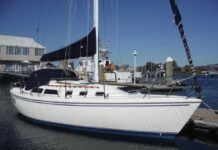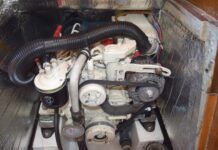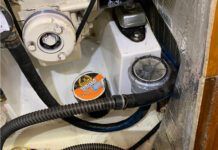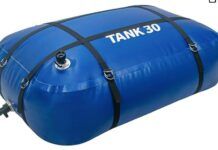
Handheld VHF radios come in handy for a variety of tasks aboard any boat. On daysailers or dinghies, they serve well as the main method of communicating-and you don’t have to worry about the mounting, antenna, and wiring issues associated with a fixed-mount radio. On larger boats with a fixed-mount VHF already installed, handhelds can serve as a viable backup radio or as a means of two-way communication if the dinghy is launched. When used as a back-up, you can even connect your handheld to the boats main antenna using an adapter and significantly increase your transceiver range.
What We Tested
To keep our reports reasonable in both scope and size, as well as to make fair comparisons, weve divided coverage of handheld VHF radios into two groups. In this review, well report on upper-echelon units that sell for more than $175. Next time, well cover less expensive radios. Our lineup includes two units from perennial VHF leader Icom (models IC-M72 and IC-M88), four from Standard Horizon (models HX370S, HX500S, HX600S, and HX471S), the Ray101 from Raymarine, and the West Marine VHF 250.
How We Tested
The first order of business was to charge the batteries, which we did using the associated AC chargers. Next, we ran each radio through a series of bench tests, including transmitter power output, frequency accuracy and stability, and receiver sensitivity. We used a sophisticated piece of radio testing gear, a Ramsey COM3010 communications service monitor.
Maximum power output on a portable handheld marine radio is limited to 5 or 6 watts. A low-power setting, 1 watt, for harbor use, is also available. In addition to the high- and low-power settings, most of the radios we tested had a mid-power setting. We tested only at the max power and 1 watt. We took transmitter power measurements directly off the radio antenna port located on the top of each radio.
Frequency accuracy is defined as the ability of the transmitter to send signals out on the selected frequency. Frequency stability measures the transmitters ability to maintain frequency accuracy over its entire temperature operating range. Regulations mandate an accuracy of 10 parts per million, while industry groups typically call for half that error. This equates to being about 1550 hertz (Hz) off frequency in the marine frequency band.
Each transmitter test was done on channel 16 at room temperature (75 degrees), as well as temperature extremes near the maximum ranges of each radio.
To reach the cold extreme, each radio was put in a bait freezer at 15 degrees for four hours prior to testing. We used a fish smoker as an environmental chamber to get the radios to high-temperature extremes. Each was left to cook for two hours at 122 degrees and then immediately run through another transmitter-power and frequency test.
We also checked each units low-power setting, measuring both power output and frequency accuracy. Frequency stability was rated over the entire range of transmitter testing; the closer a unit held to the appropriate frequency, the higher it was rated.
Receiver sensitivity is the ability of the radios receiver section to hear a weak signal. Typical marine VHF receiver sensitivity ratings run from .22 to .35 microvolts, with industry groups recommending a minimum .50 microvolts. Each radio receiver was tested for the minimum signal it could receive at a specific industry standard setting between background noise and generated signal (12 dB SINAD). All the radios rated Good or better, meaning they are more than sensitive enough to pick up very weak incoming signals.
Another receiver standard is selectivity, the ability of the receiver to reproduce only the signals you want to hear, even though they may be strong and nearby. Our test equipment did not allow us to test each radio for this characteristic. Each manufacturer provided information, which is listed in the chart under selectivity; a higher number is better.
Display ratings were based on the size of the channel number display, the amount of other information shown, the value of the channel comments, the size of the screen, and the quality of the backlighting.
To rate the audio system of each radio, we measured the sound pressure at maximum volume while generating a 1 KHz tone with the COM3010 and inputting the tone into the radio. Measurements were taken at a distance of 1 foot using a Radio Shack decibel meter. Our tester also rated each audio system with a voice input by monitoring a weather channel and rating the quality of sound reproduction.
A submersion test was conducted on each radio to confirm the manufacturers waterproof claims. The tester turned on the radios and submerged them in a bucket of fresh water for 30 minutes. After removal, we immediately checked the radio for proper operation and then checked again the next day. All of the test radios passed this test.
Since a user typically carries a handheld radio either by hand or on a belt clip, we performed a drop test to confirm the radios ruggedness. Each radio was turned on then dropped from a height of 4 feet onto concrete. Again, all test radios passed.
The clock started ticking for the battery-life test immediately following charging. We allotted the first hour of use to run our bench tests. Radios were off during their time in our environmental chambers and then allowed to run continuously for the 14 hours. We transmitted at full power for about three minutes every hour and received voice signals for about five minutes every hour until the battery died or the unit began to malfunction. Total battery test time was 15 hours. Radios still fully functional at that time were rated at 15 hours of life.
In the final analysis, we considered performance, cost (initial and battery replacement), warranty (both unit and battery), battery life, included equipment, recharge time, display, and audio output.
Icom IC-M72
Ergonomically, the IC-M72 tops the field. Its lightweight, fits into one hand well, and is comfortable to hold and use. The most powerful battery in this group provides the muscle for its six-watt transmitter, the highest output power rating of any handheld VHF weve tested. Tested battery life was excellent with the transmitter still pumping out plenty of power even after 15 hours of use. One downside: Replacing the battery will cost you nearly as much as the radio itself: $130.
Overall performance ratings on the IC-M72 were Good to Excellent, though it fell a bit short in two areas: It scored only a Fair for transmitter frequency stability because the transmitter went off frequency by a small amount after emerging from the heat chamber. It was still within design specifications and completely usable, however.
Following submersion, the battery compartment had some minor water intrusion. According to Icom advertising manager, Dave Kruzic, water in the battery area is not a problem for Icom radios. There is no huge gasket between battery and radio to prevent water intrusion. Where it is important to protect against water intrusion is where the battery contact points meet the radio mainframe. If you look at both the M72 and M88, the gasket is small and only covers this critical area. If you submerge the radios with the battery properly fitted in place, remove from water and shake the radio off, you should hear a small suction snap when removing the battery and the contact point seal is disrupted. It should be dry in that small area. The rest is unimportant.
This radio is operated with a rotary on/off/volume control located on top, a push-to-talk and squelch buttons on the side, and six pushbuttons on the front panel. Controls on the front select transmitter power, channel changing, weather, quick 16 or 9, and scanning. An optional microphone or speaker connects through a port in the top.

Bottom Line: This Icom is a well-built radio with highly rated ergonomics, good performance, and excellent battery life. Battery replacement cost is high.
Icom IC-M88
This expensive sub-compact packs a load of features into a lightweight package about the size of a bar of soap. The M88 operates by using the rotary on/off/volume control located on top and push-to-talk and squelch buttons on the side. Six front-panel pushbuttons control transmitter power, channel changing, weather, quick 16 or 9, and scanning. An optional external speaker/microphone plugs in on the side.
The M88 earned Good or Excellent ratings across the board. During the battery life test, it was one of only four radios still functioning after 15 hours, and it was going strong even then.
This radio shares two less-than-desirable traits with its sibling, the M72: It has a very expensive battery ($122) and it had some water in the battery area following our dunk test. See the Icom IC-72 text for Icoms explanation as to why water in the battery area is not a big deal.
Bottom Line: A great performer, but its expensive and so is battery replacement.
Raymarine Ray101
At about twice the size of the diminutive Icom M88, the Ray101 is the heftiest handheld in this test. It uses six AA-size nickel metal hydride batteries contained in a sealed battery pack that fits securely to the back of the unit. This setup gives the Ray101 the lowest battery replacement cost in the group, as well as the opportunity to quickly install standard AA batteries should the need arise. Unfortunately this setup also yielded the worst performance in our battery life test by lasting only nine hours. Raymarine communications manager Nancy Baumgartner commented on the Ray101 batteries. Since the battery is a consumable item, it is not covered under the three-year radio warranty. One of the major advantages of the Ray101 is that it does not use a proprietary battery pack. Instead the consumer can go to any retail store in the U.S. and buy regular AA rechargeable NiMH batteries for a fraction of the price of the proprietary custom batteries used by other radio manufacturers.
Ray101 also allows flexibility for the users to upgrade their batteries to the bigger capacity battery. Upgrading to the bigger capacity battery would instantly increase the battery life and make the radio up to date to the latest battery technology.
Two rotary knobs are mounted on the top of the unit: an off/on/volume control and a squelch control. The side-mounted push-to-talk switch is too hard to press, in our opinion. Seven front panel pushbuttons select transmitter power, scanning options, channel change, weather, panel backlighting, and quick 16.
Overall performance of the Ray101 was Good. We found water in the battery area after the dunk test. It did not penetrate the battery compartment or the area where the battery-to-radio connections are located as they are protected with a small gasket.
Bottom Line: Too big and heavy for our liking, plus it has a rather short battery life.
Standard Horizon HX600S
The HX600S is the product line leader for Vertex Standard. It features multi-band and digital-selective-calling capabilities-one of only two radios we tested with that feature. If it is sitting in its charger and the charger is wired to a GPS unit, the HX600S will transmit vessel position data along with the MMSI number when making an emergency Digital Selective Calling (DSC) call.
The HX600S has a top-mounted volume control and side-mounted pushbuttons for on-off, squelch, and push-to-talk. Eight front-mounted pushbuttons control transmitter power selection, channel changing, weather, scanning, and band choice. It can receive signals on the Marine, Aircraft, AM, and FM bands. It transmits on Marine only. The optional headset, microphone, or speaker can plug into its jack.
The HX600S was the only radio to achieve Excellent ratings across the board and pass the drop and submersion tests with no glitches or caveats. Battery life was also Excellent and rated at 15 hours. Battery replacement cost, at $65, is the lowest of any unit that requires a specialized battery.
Bottom Line: Excellent performance coupled with features like multi-band technology and DSC capability make the HX600S our Best Choice.
Standard Horizon HX500S
Identical in looks to the HX600S, the less expensive HX500S operates only on the Marine band and does not have DSC capabilities. It has a top-mounted volume control and side-mounted pushbuttons for on-off, squelch, and push-to-talk. Seven front-mounted pushbuttons control transmitter power selection, channel changing, weather, and scanning. The optional headset, microphone, or speaker can plug into a jack on the top of the unit.
The HX500S earned mostly Excellent ratings. It passed the drop and submersion tests. Though it uses the same battery as the HX600S, it did not perform quite as well, lasting almost 14 hours. When we terminated the battery life test, the HX500S was not dead-it simply stopped transmitting just seconds before it would have been set aside for the next hourly check. The HX500S has a cutout circuit that will lock out the transmitter when the battery voltage drops below a certain point. It still had life and could transmit, just not for the sustained 3 minutes we used during our testing. Battery replacement cost on the HX500S is $65.
Bottom Line: Rugged construction, very good overall performance, and a reasonably priced replacement battery make the HX500S a good choice.
Standard Horizon HX370S
Though the HX370S shares the same control layout as the more expensive HX500S and HX600S, it is bigger and heavier. It also has a larger display screen. The HX370S has a top-mounted on/off/volume control and side-mounted pushbuttons for talking and squelch. Seven pushbuttons on its face control transmitter power selection, channel changing, weather, and scanning. The jack on the radios top can accommodate a headset, microphone, or speaker.
The HX370S performed well in our testing, earning all Good and Excellent ratings. It did, however, trail the group in audio output. Submersion testing went well. The battery separated from the radio during the drop test, however. After we picked it up and reinstalled it, everything operated normally. Battery life on the HX370 was rated at 15 , though at hour 15, it was fairly weak. We don’t think this radio had much left at that point. Battery replacement is $65.
Bottom Line: A decent overall performer; its just a little big and heavy.

Standard Horizon HX471S
Even though the HX471S is the smallest and lightest radio in our test, its also packed with features like multi-band and DSC capabilities. This radio receives voice traffic on the Marine, Aircraft, Family, AM, FM, MURS, and Aircraft bands. It can transmit on Marine and Family radio channels. During a DSC emergency call, it will transmit the vessels MMSI number and-if configured properly-will relay latitude and longitude data.
HX471S has top-mounted volume and squelch knobs and a side-mounted pushbutton for push-to-talk and backlighting. Front-panel pushbuttons control transmitter power output selection, channel changing, weather, scanning, band choice, and a quick 16. Its jack can accommodate a headset, microphone, or speaker.
The HX471S performed well in our tests, earning mostly Good ratings. We noted no problems during the drop or submersion tests. Battery life on this radio was rated for 13 hours, well beyond the manufacturers 10- to 12-hour claim. Recharge time on the HX471S is the fastest in the group: three hours. Battery replacement is $83.
Bottom Line: This radio has a ton of features packed into a small package. Performance was middle of the pack.
West Marine VHF 250
In addition to full marine-band capabilities, the multi-talented VHF 250 can receive signals from the Family radio, AM, FM, and Aircraft bands. It can transmit on Family radio channels, too. Other features include a die-cast metal case and a top-mounted adapter ready to accept an optional head set, speaker, or microphone. A scrambler is also optional.
The VHF 250 is controlled with a pair of top-mounted knobs for on/off/volume and squelch, as well as seven front-panel pushbuttons for selecting the operating band, channels, weather, scanning, or quick 16 or 9. On the side is an easy-to-operate, push-to-talk switch and a backlit on-off switch.
Overall performance of the VHF 250 was Good, but the audio system was weak compared to the competition. Testing took its toll on this radio. The internal connection between the unit and the antenna failed and the antenna mount was noticeably loose. In our battery-life test, the VHF 250 lasted 14 hours, well beyond its 10-hour claim.
Bottom Line: The VHF 250 has lots of features in a reasonably priced package. A weak antenna mount holds this one back.
Conclusions
In this price range, you have plenty of options when choosing a handheld VHF. No unit stands out as a clear winner in every category. The Standard Horizon HX600S is our Best Choice because it performed well-with no hiccups-and had a bevy of added features, including the ability to listen on several voice bands and transmit a DSC call in an emergency. It is certainly not the smallest, lightest, or least expensive handheld out there, but as an overall package, we think its the best. If youre looking for a radio with the longest battery life, opt for either the IC-M72 or the IC-M88. Both had plenty of juice left at the end of our grueling battery test. Technology enthusiasts trying to stay on the edge should look at the Standard Horizon HX471S. The HX370S, the PS Budget Buy, is only $20 less than the M72, but youll save more in the long run with a cheaper battery replacement.
Contacts
Standard Horizon, 714/827-7600, www.standardhorizon.com
Icom, 425/454-7619, www.icomamerica.com
West Marine, 800/262-8464, www.westmarine.com
Raymarine, 800/539-5539, www.raymarine.com



































